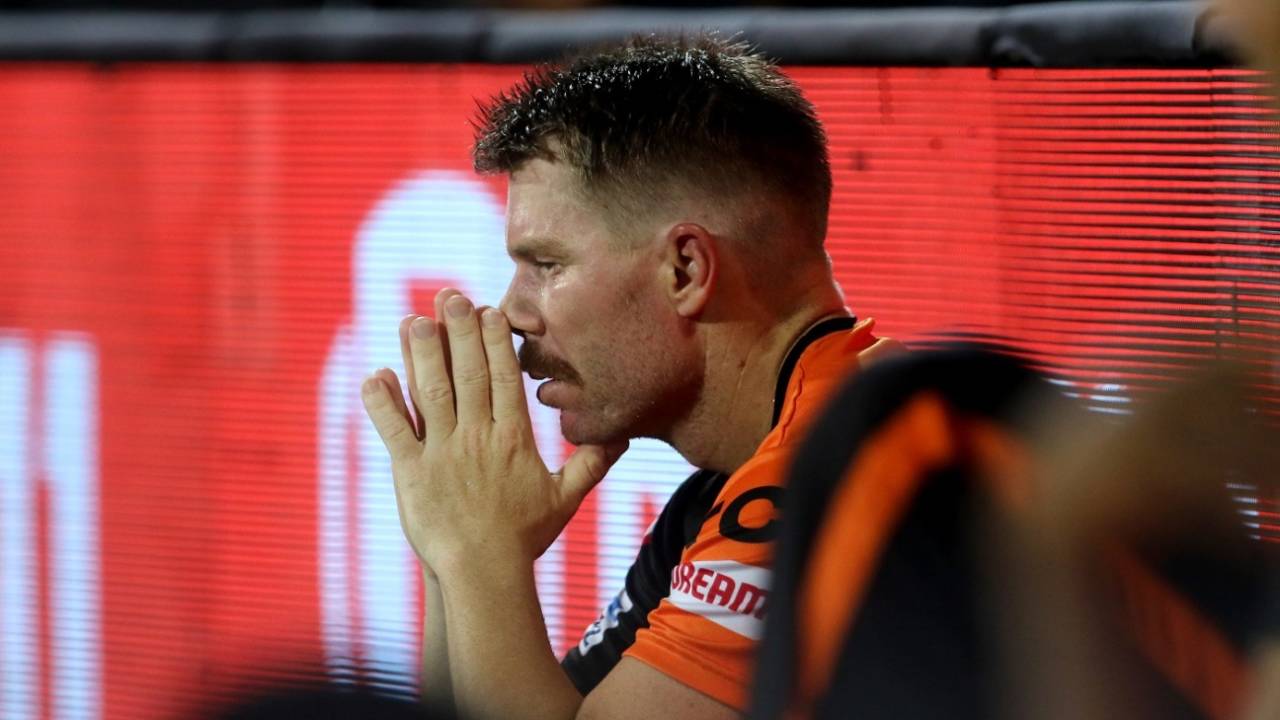Talking Points: Are quick singles really worth the risk?
Plus, the method behind Rashid Khan's mastery over Ishan Kishan
Hemant Brar
17-Apr-2021
David Warner's run-out dismissal was a key moment in the Sunrisers' failed chase of 151 • BCCI/IPL
Talking points from the Mumbai Indians' 13-run win over the Sunrisers Hyderabad at Chepauk.
Are quick singles really worth the risk?
Rohit Sharma vs the Royal Challengers Bangalore. Rishabh Pant vs the Rajasthan Royals. KL Rahul vs the Chennai Super Kings. And now David Warner against the Mumbai Indians.
Rohit Sharma vs the Royal Challengers Bangalore. Rishabh Pant vs the Rajasthan Royals. KL Rahul vs the Chennai Super Kings. And now David Warner against the Mumbai Indians.
That's four key batters, coincidentally all of them captains, going for quick singles and getting run out in the process. Except Rahul, the other three were not even close to making their ground. On all four occasions, their side went on to lose the match. It begs the question: are singles really worth risking one's wicket, when plenty of overs are still left?
At the recent MIT Sloan Sports Analytics Conference, the former India captain Rahul Dravid, who has also led and coached in the IPL, said: "The day is not far when people are going to turn down a single because the match-up suits them to hit a six in the remaining two or three balls [of the over]."
Turning down a quick single that risks a run-out is, you would think, an even easier decision.

Why run quick singles at all?•ESPNcricinfo Ltd
Why did Mumbai hold Chahar back?
Rahul Chahar picked up 4 for 27 at this very venue in Mumbai's previous match, turning the game around just when the Kolkata Knight Riders seemed to be cruising to their target of 153. Chahar eventually won the Player of the Match award as Mumbai registered a last-over win.
Rahul Chahar picked up 4 for 27 at this very venue in Mumbai's previous match, turning the game around just when the Kolkata Knight Riders seemed to be cruising to their target of 153. Chahar eventually won the Player of the Match award as Mumbai registered a last-over win.
On Saturday, despite Warner and Jonny Bairstow going berserk while chasing a similar target, Chahar didn't bowl a single ball until the ninth over. This may have been because Chahar has a bad match-up against Warner. Before this match, Warner had ransacked 40 off 22 balls from Chahar without being dismissed. Mumbai didn't want to take that risk.
When Chahar eventually came on, Warner took ten from the six balls he faced from the legspinner before being run out. Against the rest of the Sunrisers batters, Chahar conceded only eight from 18 deliveries while dismissing three of them.
Have Rohit Sharma's middling returns gone under the radar?
He is the most successful IPL captain, having won five titles with the Mumbai Indians, but over the last few years, Sharma the batter has been sub-par.
He is the most successful IPL captain, having won five titles with the Mumbai Indians, but over the last few years, Sharma the batter has been sub-par.
Since the start of the 2017 season, Sharma has batted 57 times in the top four in the IPL and scored 1413 runs at an average of 26.66 and a strike rate of 127.52. Generally, top-order batters with such numbers don't get a long rope. The only other batter to have played more than 25 innings in the top four in that period with an average below 30 and a strike rate under 130 is Ajinkya Rahane.
But apart from his exceptional record as captain, Sharma also benefits from a batting line-up brimming with match-winners. His middling returns, therefore, haven't necessarily hurt Mumbai, and when the stakes have been high, like in the final of IPL 2020, Sharma has often stepped up.

When wrong ('un) is right•ESPNcricinfo Ltd
How Rashid Khan aced his match-up against Ishan Kishan
In IPL 2020, Ishan Kishan had dominated Rashid Khan, smashing 33 runs off 20 balls without a single dismissal. No other batter took more runs off Khan last year. Among those who faced at least ten balls from him, only Shane Watson and Nitish Rana scored at a higher rate.
In IPL 2020, Ishan Kishan had dominated Rashid Khan, smashing 33 runs off 20 balls without a single dismissal. No other batter took more runs off Khan last year. Among those who faced at least ten balls from him, only Shane Watson and Nitish Rana scored at a higher rate.
On Saturday, though, Kishan could manage only six runs off 10 balls against Khan. What changed?
In 2020, Khan had bowled 11 legbreaks to Kishan, off which the left-hand batter took 23 runs. The remaining nine were googlies; Kishan scored only ten off those. This time Khan bowled almost exclusively googlies against Kishan. Of the ten balls he bowled to Kishan, nine were wrong 'uns. Only one was a legbreak. Kishan scored only six runs off the googlies, while the legbreak was a dot.
In all, Khan bowled 22 googlies in the match (one was a wide), the second-most by a bowler in any IPL game for which ESPNcricinfo has bowling-variations data. Only Ravi Bishnoi has bowled more: 23 (two of them were wides) against the Royal Challengers last year.
Khan may have bowled as many googlies as he did because he predominantly bowled to left-handers. He bowled nine googlies in ten balls to Quinton de Kock as well, and those nine balls went for just 10 runs. While Khan failed to pick up any wickets, he was miserly as usual, conceding only 22 from his four overs.
Hemant Brar is a sub-editor at ESPNcricinfo
